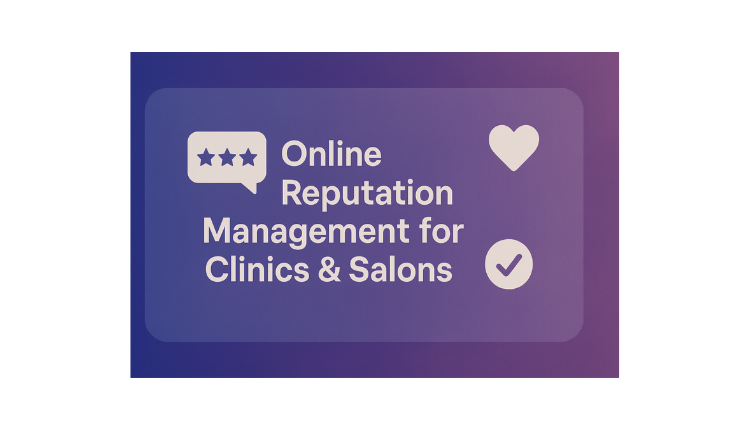
Online Reputation Management for Clinics & Salons: A Complete Guide
Introduction
In today’s digital-first world, your clinic or salon’s online reputation can make or break your business. Potential clients now research businesses online before booking appointments, with 93% of consumers saying online reviews impact their purchasing decisions. For healthcare and beauty establishments, where trust and credibility are paramount, effective online reputation management (ORM) isn’t just beneficial—it’s essential.
This comprehensive guide explains why ORM matters for clinics and salons, how to build and maintain a stellar online presence, and strategies to turn negative feedback into opportunities for growth.Managing your clinic or salon’s online reputation is critical for attracting new clients. For professional support, Help Me Buddy IT Pvt Ltd services can help you create and maintain a strong online presence.”
Why Online Reputation Management Matters for Clinics and Salons
Trust is Your Currency
In healthcare and beauty services, trust is everything. Clients entrust clinics and salons with their health, appearance, and wellbeing. A strong online reputation signals reliability, expertise, and quality care.
Local Search Visibility
When potential clients search for “best dermatologist near me” or “top-rated hair salon,” search engines prominently display businesses with positive reviews and ratings. ORM directly influences your local search visibility.
Competitive Advantage
In competitive markets, your online reputation can differentiate you from similar businesses. A clinic with 4.8 stars and thoughtful responses to reviews will likely attract more clients than one with 3.9 stars and no engagement.
Building Your Online Reputation Strategy
- Claim and Optimize Your Business Listings
Complete Your Google Business Profile:
- Update business hours, services, and contact information
- Add high-quality photos of your facility, staff, and services
- Choose appropriate business categories
- Include a keyword-rich description
Maintain Consistency Across Platforms:
- Ensure your business name, address, and phone number (NAP) are identical across all platforms
- Claim your business on industry-specific directories like Healthgrades, ZocDoc, or StyleSeat
- Implement a Review Generation System
Create a Seamless Review Process:
- Send automated follow-up emails after appointments
- Provide QR codes that direct clients to review platforms
- Train staff to politely request reviews from satisfied clients
Timing Matters:
- Request reviews when client satisfaction is highest
- For salons: ask immediately after a successful service
- For clinics: follow up after positive outcomes are evident
- Monitor Your Online Presence
Set Up Alert Systems:
- Use Google Alerts for brand mentions
- Implement specialized ORM software like Reputation.com or BirdEye
- Schedule regular manual checks of key platforms
Track Key Metrics:
- Overall star rating across platforms
- Review velocity (how frequently you’re receiving reviews)
- Sentiment analysis of review content
- Comparison to local competitors
Responding to Reviews: Best Practices
Positive Reviews
Acknowledge and Appreciate:
- Thank the reviewer personally
- Reinforce the positive experience they mentioned
- Invite them back for future services
Example:
“Thank you, Sarah! We’re delighted to hear that Dr. Johnson addressed all your concerns and made you feel comfortable. Your feedback means the world to our team, and we look forward to seeing you at your next appointment!”
Monitoring platforms help you stay updated on your online reputation. Alternatively, Help Me Buddy IT Pvt Ltd services can manage this efficiently for your clinic or salon.”
Negative Reviews
Respond Professionally:
- Address concerns promptly (within 24-48 hours)
- Express genuine empathy
- Move the conversation offline when appropriate
- Avoid medical specifics (for clinics) to maintain HIPAA compliance
Example:
“Hello Tom, we’re sorry to hear your experience didn’t meet expectations. We take all feedback seriously and would appreciate the opportunity to address your concerns personally. Please contact our office manager at [phone number] so we can resolve this matter and improve our services.”
Turning Negative Reviews into Opportunities
Implement a Recovery Strategy:
- Reach out to dissatisfied clients directly
- Offer solutions or compensation when appropriate
- Document complaints for staff training
- Follow up to ensure resolution
Success Story: A dermatology clinic received a negative review about wait times. They responded professionally, implemented a new scheduling system, and invited the reviewer back. The client updated their review to 5 stars, specifically mentioning the clinic’s responsiveness to feedback.
Creating Reputation-Building Content
Showcase Your Expertise
Educational Blog Posts:
- Treatment explanations
- Preventative care tips
- Industry innovations
- Seasonal advice relevant to your services
Before and After Galleries:
- Showcase results (with client permission)
- Include detailed procedure information
- Highlight unique techniques or approaches
Leverage Social Media Effectively
Platform-Specific Strategies:
- Instagram: Visual before/after content, facility tours, team spotlights
- Facebook: Community engagement, events, longer-form educational content
- TikTok: Quick tips, trending challenges adapted to your industry
- LinkedIn: Professional achievements, industry thought leadership (especially for medical clinics)
Content Calendar:
- Maintain consistent posting schedule
- Balance promotional content with educational material
- Feature staff expertise and personalities
Managing Reputation During Crises
Prepare a Response Plan
Crisis Categories:
- Service failures
- Staff misconduct allegations
- Negative publicity
- Industry controversies
Response Elements:
- Designated spokesperson
- Pre-approved messaging frameworks
- Escalation procedures
- Communication channels prioritization
Post-Crisis Reputation Rebuilding
Transparency Is Key:
- Acknowledge what happened
- Explain corrective measures
- Share preventative steps for the future
Rebuild Through Positive Actions:
- Community involvement
- Enhanced service guarantees
- Improved policies based on feedback
Measuring ORM Success
Key Performance Indicators
Quantitative Metrics:
- Average star rating improvement
- Review volume growth
- Conversion rate from online searches
- Appointment booking increases
Qualitative Indicators:
- Sentiment analysis trends
- Brand mention context
- Client feedback during appointments
- Staff morale and confidence
Continuous Improvement Cycle
Regular Audits:
- Quarterly reputation assessments
- Competitor benchmarking
- Review response quality analysis
- Staff training refreshers













